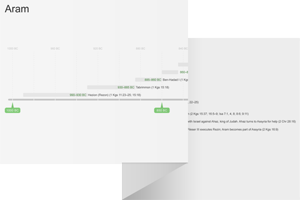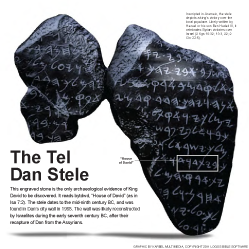7:1 in the days of Ahaz The events of ch. 7 take place around 735 bc (see 2 Kgs 15:37–16:8). Aram (also known as Syria) and Israel have joined forces to rebel against the Assyrian Empire. They are trying to force Judah to join their rebellion.
of ch. 7 take place around 735 bc (see 2 Kgs 15:37–16:8). Aram (also known as Syria) and Israel have joined forces to rebel against the Assyrian Empire. They are trying to force Judah to join their rebellion.
7:2 the house of David May be an attempt to highlight Ahaz’s lack of faith. The address highlights God’s promise to preserve David’s family on the throne of Jerusalem (2 Sam 7:8–17).
7:3 Shear-Jashub your son Isaiah’s sons are given symbolic names as living reminders of God’s message (compare Hos 1:4–9). “Shear-jashub” refers to the return of the remnant, which symbolized both judgment and the hope of future restoration.
 Symbolic Names of People in Hebrew Table
Symbolic Names of People in Hebrew Table
7:6 the son of Tabeel Probably a puppet ruler to replace Ahaz and bring Judah into their alliance.
7:8 in sixty-five years from now When Israel was conquered by Assyria in 722 bc, a large part of the population was taken into exile. Assyria then resettled the land with exiles from other areas they conquered. The resulting mixed population within two generations could be referred to here. The 65-year figure has no specific historical significance.
7:10–25 Isaiah’s meeting with Ahaz should have encouraged his faith in Yahweh to deliver Judah from its present predicament. Instead, Ahaz discounts the reassurance Yahweh offers, and compounds his sin by refusing a divine sign. The sign of Immanuel |
7:11 make it deep as Sheol The sign can be otherworldly and supernatural.
 Old Testament Theology of the Afterlife
Old Testament Theology of the Afterlife
7:12 I will not put Yahweh to the test Ahaz’s refusal to ask for a sign is rebellious, not pious.
7:14 the virgin The Hebrew term here, almah, indicates a young woman of marriageable age. In the ancient world, a young unmarried woman who had reached puberty could reasonably be assumed to be a virgin because of the close social and familial restrictions on her activities.
God with us Means “God with us.” The three symbolic names of these children point to the three phases of God’s future work: imminent judgment, coming restoration, and future redemption (compare Isa 7:3; 8:1).
7:16 to reject the evil and to choose the good The sign for Ahaz is meant to indicate that the threat from Aram (Syria) and Ephraim is short term and will pass within a few years. By the time the boy has been born—but before he knows right from wrong—Aram and Ephraim will be out of the picture.
7:18 the bee that is in the land of See 5:26. God will use the nations to judge Israel and Judah. Their soldiers will swarm over the land like insects.
7:20 with a razor of Forcibly shaving the head and beard was a way of humiliating your enemy. See 2 Sam 10:4–5 and Ezek 5:1.
the hair of the feet The Hebrew term here is sometimes used as a euphemism for genitalia. See Exod 4:25.
for genitalia. See Exod 4:25.
7:22 the abundance of milk production The population will be so reduced that a handful of livestock will provide more than enough food.

|
About Faithlife Study BibleFaithlife Study Bible (FSB) is your guide to the ancient world of the Old and New Testaments, with study notes and articles that draw from a wide range of academic research. FSB helps you learn how to think about interpretation methods and issues so that you can gain a deeper understanding of the text. |
| Copyright |
Copyright 2012 Logos Bible Software. |
| Support Info | fsb |
 Loading…
Loading…



